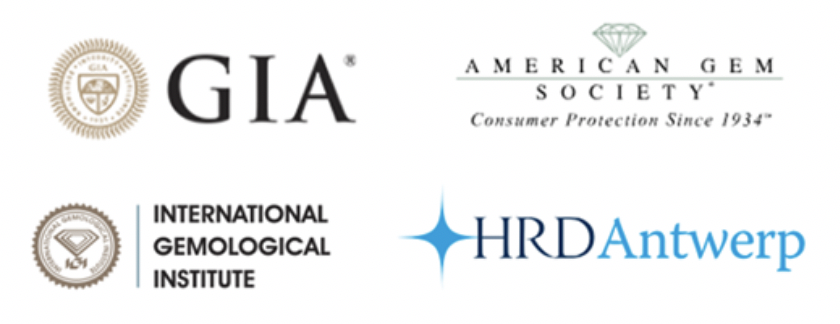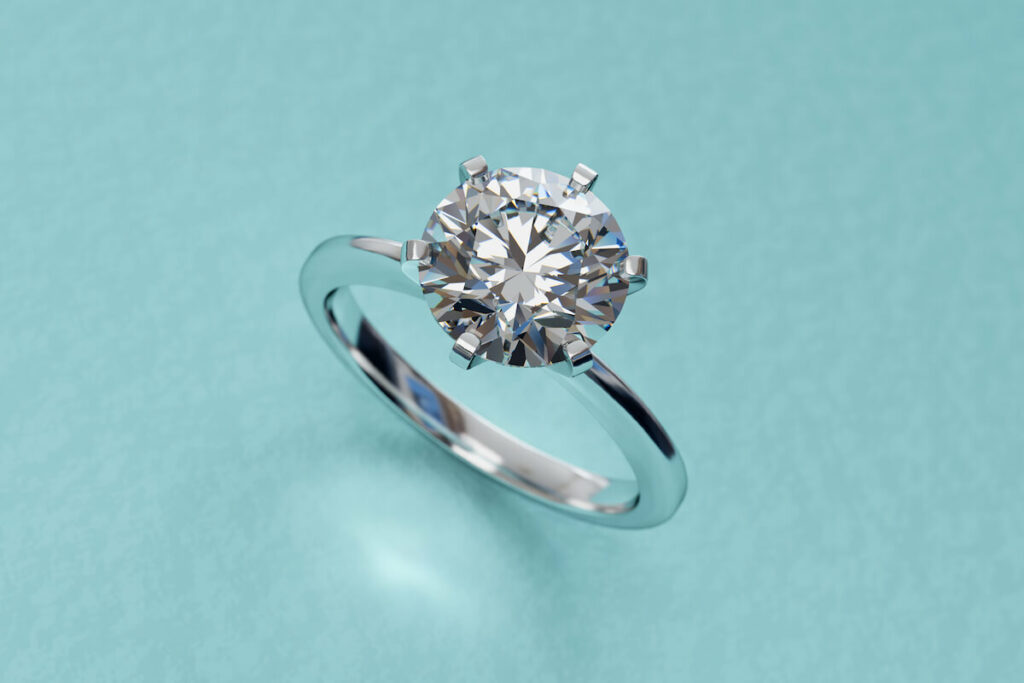A grading report is a scientific blueprint of a diamond’s authenticity. Grading Reports are also referred to as a “diamond certificate”. This certification has essential information about the quality and characteristics of the diamond and provides, when issued by an independent laboratory, an unbiased analysis of a diamond’s specific qualities.
Obtaining a certified grading report for any diamond purchase will provide confidence that you are purchasing a natural diamond. It will also disclose any treatment to enhance color or clarity. For consumers who want the assurance of getting exactly what is described regarding a diamond’s qualities, should only purchase diamonds with a certification provided by an independent professional gemological evaluating laboratory such as GIA, AGS, IGI or HRD.
The report assesses and verifies the quality of a diamond by describing the “Four Cs” – color, cut, clarity and carat weight. However, there is much more to buying a diamond than knowing the 4 Cs.
Although some retailers provide their own “certification,” its best that the certification not be associated with the retailer or wholesaler selling you the diamond. You want to be completely confident that the attributes of the diamond have been independently researched rather than accepting the description provided by a persuasive sales person.
You may be provided with an appraisal by the seller or purchase one for insurance. However, a certified laboratory report and appraisal are not the same. Appraisals are the estimated value for insurance purposes, not what the diamond cost or its exact qualities.
Besides the evaluation of the diamond, a certified lab report is also important when selling your jewelry or providing your insurance company with accurate information to protect your investment.
On most certificates, information such as the measurements, shape and if applicable, the laser inscription registry number will be noted. The analyses will also include the degree of fluorescence (if present) in the diamond.
The Four C’s
The 4Cs of a Diamonds quality (Color, Cut, Clarity and Carat weight) was first created by GIA – Gemological Institute of America, in the mid 1950’s as a way for quality to be communicated in a universal language. This allowed customers to know exactly what qualities to look for in the diamond they were about to purchase. This became the accepted standard by which diamonds would be judged worldwide. GIA (a non-profit organization) also became the world’s most trusted source for unbiased assessment of gemstones.
Color
A diamonds color actually means the lack or absence of color. A diamond with no color (hue) is much like the hue of a drop of water. Under perfect lighting conditions using a set of masterstones of established color value, a diamond is graded by GIA’s D-to-Z color-grading system which measures the degree of colorlessness in the diamond. A perfect diamond would have no color. The exceptions to this rule are the rare colors of red, blue, pink and orange which is much sought after and called Fancy colors.
Clarity
A diamonds clarity refers to the absence of blemishes (external characteristics) and inclusions (internal characteristics). A skilled gemologist will examine the diamond using a 10X powered Microscope and be able to determine the clarity rating. Those findings will be listed on the certificate as follows:
Visible under a 10X magnification
- (FL) Flawless diamonds have no blemishes or inclusions.
- (IF) Internally Flawless
- (VVS1 & VVS2) Very, Very Slightly Included
- (VS1 & VS2) Very slightly included, minor
- (SI1 & SI2) Inclusions are noticeable
- (I1, I2, I3) Inclusions are obvious
Cut
The shape of the diamond is sometimes confused with the cut however the shape refers to the outline of a diamond and the cut refers to the combination of a diamond’s proportions and finishing – (symmetry/polish). It is the cut that enables a diamond to make the best use of light. Increased light makes the diamond appear whiter since more light is reflected back to the viewer. A well cut diamond will display an intense scintillation and fire which can easily hide inclusions under its sparkle improving the other aspects of the diamond.
Carat Weight
A diamond’s carat weight measures how much it weighs and its apparent size. A metric carat is designated at 200 milligrams. A carat can be subdivided into 100 “points”. To precisely measure to the hundredth decimal place, a metric carat which is 200 milligrams may refer to a diamond that weighs 0.50 as a “50 pointer” or ½ carat. A diamond that is 1.04 would be referred to as 1 point 04 carats.
The Five major Gemological Laboratories


GIA Gemological Institute of America
The Gemological Institute of America (GIA) is the largest, most recognized and respected nonprofit gemological laboratory in the world. They created the 4Cs and the International Diamond Grading System™. GIA offers two certificates, a Diamond Dossier and a Diamond Report or certificate.
The Diamond Dossier provides all the information found on the certificate with the addition of the diamond’s fluorescence level and measurements. The Dossier can be provided with or without cut information. If the stone’s cut information is included, it will provide the table size, pavilion angles, girdle thickness and table size. The GIA cut scale ranges from Excellent to Very Good, Good, Fair, and Poor
The Diamond grading report is a full report providing the 4Cs, all the details found in the Diamond Dossier plus providing a diagram of the diamonds blemishes and inclusions.
American Gemological Laboratories
When it comes to colored gemstones, American Gemological Laboratories (AGL) is one of the most trusted and respected resources in the industry. Their comprehensive colored stone analysis can provide information on a gemstone’s country-of-origin, as well as any enhancements or treatments that may be present. AGL offers different gem identification services, ranging from full size gemstone portfolios and appendix letters, to credit card sized GemBrief™ reports as a low-cost alternative.
The following gem species that are eligible for an AGL origin report include: Sapphire (all colors), Ruby, Alexandrite, Paraiba or Paraiba-type tourmaline, Emerald, Demantoid Garnet, Cobalt Spinel, and Pink to Red Spinel. For certain gemstones that are only found in one geographical location, AGL will indicate the origin on the report at no additional cost. Examples of single-location gemstones include: Benitoite (USA – California), Red Beryl (USA – Utah), Tsavorite (East Africa), and Tanzanite (Tanzania).
The American Gem Society
The American Gem Society (AGS) is the second most widely used gemstone laboratory after GIA. They also have rigid, ethical standards in grading gemstones. Their “Diamond Quality Document” is their basic evaluation certificate but they also offer a wide range of other report options.
Instead of the D to Z for color and VVS1 to I3 for clarity used by GIA, AGS uses a proprietary 0-10 grading system for cut, color, and clarity. To aid those familiar with the GIA grading system, their report also provides the GIA letter equivalents to the AGS number scale.
The highest grade on AGS scale is zero and 10 is the lowest. Therefore, a diamond with a color grade of 5 would have less color than a diamond with a color grade of 7. Using AGS grading system, a perfect diamond would be a 0-0-0, which is the highest rating in Cut, Color and Clarity.
HRD Antwerp (Hoge Raad voor Diamant)
HRD’s Antwerp grading reports are called a “Natural Diamond Certificate” which like GIA and AGS, describe the four Cs and a detailed schematic of the gemstones blemishes and inclusions. Their reports are considered the hallmark of authentic European quality.
Their grading system is like GIA’s D to Z rating however, instead of letters they provide a scale from Exceptional White to Tinted Color. Their Clarity is graded from Loupe Clean which is the equivalent to Flawless to P3 which is imperfect. Clarity is also assessed by proportions with a range from Very Good, Good, to Unusual.
Another feature HRD provides to protect you from a counterfeit diamond, is an exclusive security feature in each grading report which is only visible by a loupe or UV-light.
International Gemological Institute
The International Gemological Institute (IGI) has labs throughout the world. Even though IGI Diamond Reports include most of the same analysis as GIA, AGS and HRD, they (as does EGL) apply different criteria standards and provide a more relaxed assessment. When assessing the four C’s, GIA might grade a diamond as a SI2 that IGI might grade as a VS1 or VS2. Colors are most often one grade higher than GIA.
Having a GIA report, and or appraisal is beneficial in establishing value, though not a necessity. Regal Estate Jewelry Buyers’ GIA graduate gemologists have decades of appraisal experience, assuring the highest offer for your diamond jewelry.
Call toll free: 1-866-475-5389

